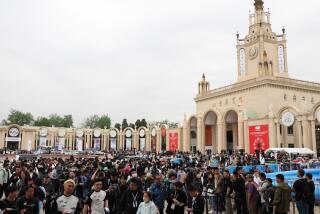China doesnât own the future
The conventional wisdom is that China is rising and the United States is on its way down. According to this view, the 21st century challenge for U.S. foreign policy is to manage our inevitable decline as gracefully as possible as the new superpower of the East reaches for the stars.
The conventional wisdom almost always sounds smart -- and is almost always wrong. The U.S. doesnât need to contain China, and it doesnât need to fight China either. Nor does it need to prepare to gracefully let China replace the United States as the worldâs leading power.
The first reason is simple. The rise of China is only part of a much bigger story -- the rise of Asia. China isnât ascending in a vacuum, destined to dominate its region the way the U.S. dominates the Western Hemisphere -- or the way Germany once tried to dominate Europe.
China is rising, but so is India. So are Vietnam, Indonesia, Thailand and Korea (where South and North may be united before too much longer). Japan will remain a powerful economic, military and technological force for the foreseeable future. Taiwan is not sinking into the sea; Australia is prospering as never before. Bangladesh is beginning to industrialize; even Myanmar, or Burma, may possibly follow the road to prosperity through global economic integration that has made East and South Asia growth rates the envy of the world.
Some Americans look at this picture and think that the other rising Asian powers can help the U.S. contain China. This is a mistake not only because other Asian countries are uninterested in hostile relations with a rich and powerful country like China but because it looks less and less as though the U.S. will need to contain Beijing.
The new Asia taking shape is too big, too diverse, too independent and too rich for one country to rule. Not China, not the United States, not India.
Asiaâs Big Three -- China, India and Japan -- are in rough balance. Any two of them are economically and militarily strong enough to prevent the third from dominating the region. India and Japan could balance China. China and Japan could balance India. And Japanâs dreams of dominating the Pacific died in 1945. With the U.S. also prepared to defend the balance of power in Asia, it seems unlikely that China, or any other nation, will waste time and money in the effort to overturn it.
China will continue to modernize its military and test the limits of its power. But for it to build armed forces that could overcome the combined might of the U.S., India and Japan is not now, and probably never will be, a feasible project.
In terms of world power, there will be five big players -- the U.S., the European Union and the Asian Big Three. But of these, the U.S. will continue to play a unique role because it will be a vital part of the Asian balance of power as well as of the European one.
In looking to Asiaâs future, itâs important to realize that numbers arenât everything. In 1700, China, India and France all had more people and bigger economies than Britain -- but it was Britain that became a world power. The U.S. today is bigger, stronger and richer than Britain ever was; our share of world gross domestic product is three times Britainâs share at its peak.
Thanks to the one-child policy, Chinaâs population may have peaked -- and the U.S. is still rapidly growing. If demographers are correct, by 2050 there will be about 1.4 billion Chinese (up from 1.3 billion) and about 400 million Americans (up 100 million).
The comparison between the two countries is even more dramatic in terms of labor forces. Today, there are about 948 million working-age people in China and about 202 million in the United States. Because of the one-child policy, Chinaâs population will age faster than in the U.S. and, in 2050, there will be about 248 million working-age Americans -- and 860 million Chinese.
Preoccupied with their own problems and concerns, Americans often miss how serious other countriesâ problems are. Chinaâs population crisis means that it will face a greater crisis caring for an elderly population with a smaller workforce. The countryâs other problems are formidable as well and will keep it busy for decades: cleaning up its environment, developing a financial system that can keep pace with a modernizing economy and creating an effective healthcare system. Then there is the question of devising a system of government strong enough to administer a country the size of China yet flexible enough to meet local needs -- and that allows dissent and political competition but does not fly apart into disunity.
There is one other factor at work. Ever since the U.S. moved to rebuild relations with China under President Nixon, it has been trying to persuade China to engage with the international system -- to behave more like a ânormalâ country. That policy over time has been a spectacular success. Although the transition is not yet complete, China has come to believe that its interests are best served by participating in regional organizations and summits and by joining such organizations as the World Trade Organization.
Chinaâs pride at hosting the 2008 Summer Olympics is a sign of how far this transformation has gone. Just 40 years ago, it was news when the Chinese invited a group of Americans to play ping-pong. Now China has the ability -- and the will -- to host the most high-profile, expensive and complex festival in the world of international sport.
Promoting the peaceful development of Asia, ensuring that smaller countries are not threatened by their large neighbors and helping the Asian superpowers to find a set of economic and security relationships that can keep the region peaceful as it passes through the greatest economic and social transformation in world history -- those should be the goals of U.S. policy in Asia this century.
If we get that right, and if we preserve the social dynamism at home that is the basis of our global role, we will promote the rise of democracy and prosperity in Asia and build a better world for the future.
More to Read
Sign up for Essential California
The most important California stories and recommendations in your inbox every morning.
You may occasionally receive promotional content from the Los Angeles Times.










